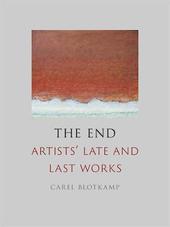
|
The End: Artists' Late and Last Works
Hardback
Main Details
| Title |
The End: Artists' Late and Last Works
|
| Authors and Contributors |
By (author) Carel Blotkamp
|
| Physical Properties |
| Format:Hardback | | Pages:248 | | Dimensions(mm): Height 208,Width 156 |
|
| Category/Genre | Theory of art
Art History |
|---|
| ISBN/Barcode |
9781789141313
|
| Classifications | Dewey:709 |
|---|
| Audience | | Postgraduate, Research & Scholarly | | Further/Higher Education | | Professional & Vocational | | General | |
|---|
| Illustrations |
60 illustrations, 24 in colour
|
|
Publishing Details |
| Publisher |
Reaktion Books
|
| Imprint |
Reaktion Books
|
| Publication Date |
14 October 2019 |
| Publication Country |
United Kingdom
|
Description
When is a work of art finished? Can it be complete in a mental sense? And who decides? In this highly original and wide-ranging study, Carel Blotkamp explores the concept and manifestations of 'the end' in art. From the idea of a mortal end to the notion of completeness, Blotkamp describes a fascinating array of historical facts and myths as well as novels on art and artists. He examines the value of the last works of artists, considering how a particular end came about and how that might affect our perception of the work; the difference in the styles of artists in old age; unfinished last works and those completed by another's hand; and the mythology inherent in the reception of last works, taking the last works of Raphael and Mondrian as prime examples. For students, artists and art enthusiasts looking for a new perspective on modern art, The End is the perfect place to start.
Author Biography
Carel Blotkamp is Professor Emeritus of the History of Modern Art at Vrije Universiteit, Amsterdam and a well-known authority on Mondrian and De Stijl. He is the author of Mondrian: The Art of Destruction (Reaktion, 2001).
Reviews"Blotkamp discerns late style in Claude Monet, Pierre Bonnard, Max Beckmann, Alberto Giacometti, Lucian Freud, and Louise Bourgeois--artists who kept innovating over long lives. Others--Blotkamp suggests Georges Braque, Marc Chagall, Salvador Dali, Max Ernst--seem either to exhaust themselves or to veer from the aerie of lateness into the lower realms of the predictable, old-fashioned, and, perish the thought, commercial. . . . Late style may be the visual expression of what it feels like to face the end--or it may be nothing more than a critic's fantasy, a by-product of our hunger for hidden meanings, narrative closure, and valedictory statements. More likely, it is both at once: the subjective expression of an artist, viewed subjectively."--Max Norman "New Yorker"
|